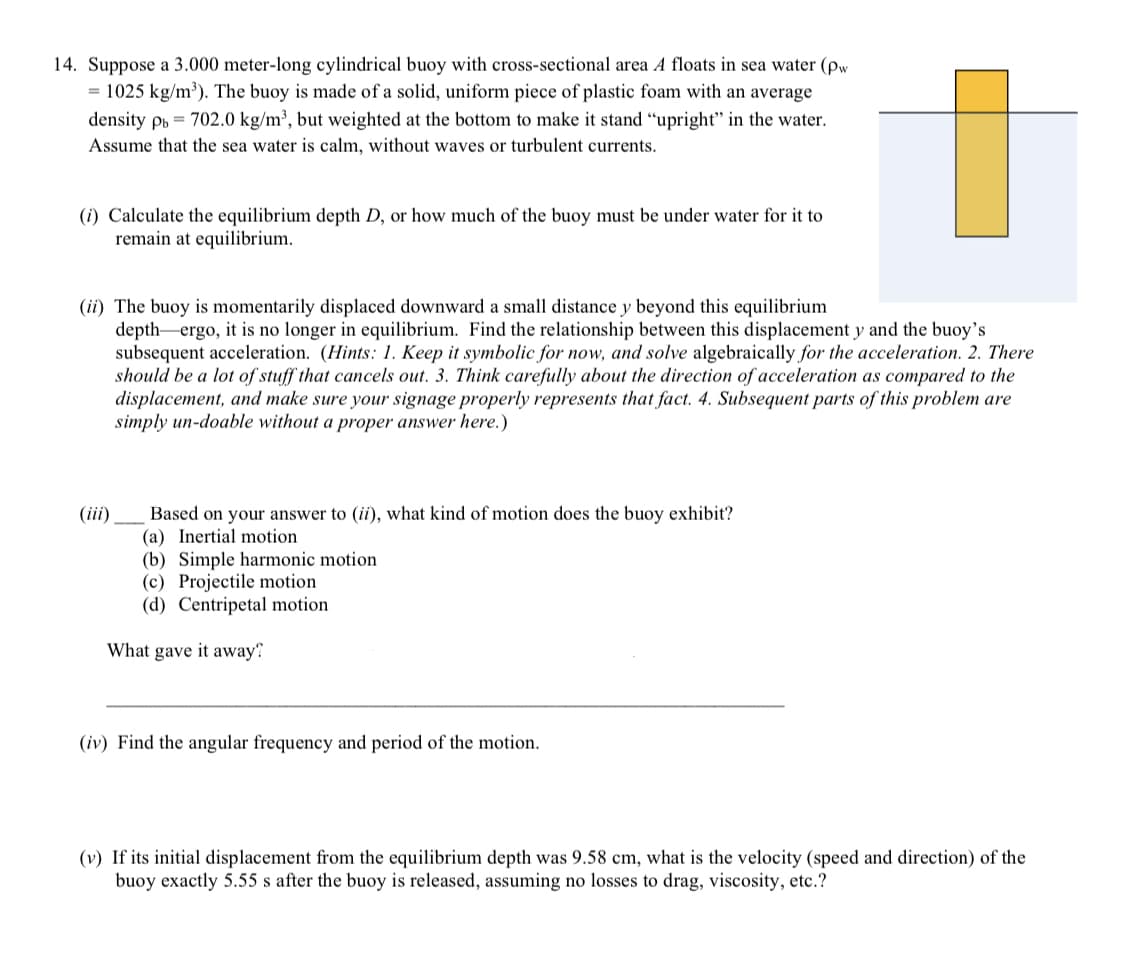(iv) Find the angular frequency and period of the motion. (v) If its initial displacement from the equilibrium depth was 9.58 cm, what is the velocity (speed and direction) of the buoy exactly 5.55 s after the buoy is released, assuming no losses to drag, viscosity, etc.?
(iv) Find the angular frequency and period of the motion. (v) If its initial displacement from the equilibrium depth was 9.58 cm, what is the velocity (speed and direction) of the buoy exactly 5.55 s after the buoy is released, assuming no losses to drag, viscosity, etc.?
Principles of Heat Transfer (Activate Learning with these NEW titles from Engineering!)
8th Edition
ISBN:9781305387102
Author:Kreith, Frank; Manglik, Raj M.
Publisher:Kreith, Frank; Manglik, Raj M.
Chapter6: Forced Convection Over Exterior Surfaces
Section: Chapter Questions
Problem 6.34P
Related questions
Question
Hello, I need help solving(iv and v) with explanations. Please and thank you.

Transcribed Image Text:14. Suppose a 3.000 meter-long cylindrical buoy with cross-sectional area A floats in sea water (pw
= 1025 kg/m³). The buoy is made of a solid, uniform piece of plastic foam with an average
density pb = 702.0 kg/m², but weighted at the bottom to make it stand “upright" in the water.
Assume that the sea water is calm, without waves or turbulent currents.
(i) Calculate the equilibrium depth D, or how much of the buoy must be under water for it to
remain at equilibrium.
(ii) The buoy is momentarily displaced downward a small distance y beyond this equilibrium
depth-ergo, it is no longer in equilibrium. Find the relationship between this displacement y and the buoy's
subsequent acceleration. (Hints: 1. Keep it symbolic for now, and solve algebraically for the acceleration. 2. There
should be a lot of stuff that cancels out. 3. Think carefully about the direction of acceleration as compared to the
displacement, and make sure your signage properly represents that fact. 4. Subsequent parts of this problem are
simply un-doable without a proper answer here.)
Based on your answer to (ii), what kind of motion does the buoy exhibit?
(a) Inertial motion
(b) Simple harmonic motion
(c) Projectile motion
(d) Centripetal motion
(iii)
What gave it away
(iv) Find the angular frequency and period of the motion.
(v) If its initial displacement from the equilibrium depth was 9.58 cm, what is the velocity (speed and direction) of the
buoy exactly 5.55 s after the buoy is released, assuming no losses to drag, viscosity, etc.?
Expert Solution
This question has been solved!
Explore an expertly crafted, step-by-step solution for a thorough understanding of key concepts.
Step by step
Solved in 3 steps with 3 images

Knowledge Booster
Learn more about
Need a deep-dive on the concept behind this application? Look no further. Learn more about this topic, mechanical-engineering and related others by exploring similar questions and additional content below.Recommended textbooks for you

Principles of Heat Transfer (Activate Learning wi…
Mechanical Engineering
ISBN:
9781305387102
Author:
Kreith, Frank; Manglik, Raj M.
Publisher:
Cengage Learning

Principles of Heat Transfer (Activate Learning wi…
Mechanical Engineering
ISBN:
9781305387102
Author:
Kreith, Frank; Manglik, Raj M.
Publisher:
Cengage Learning